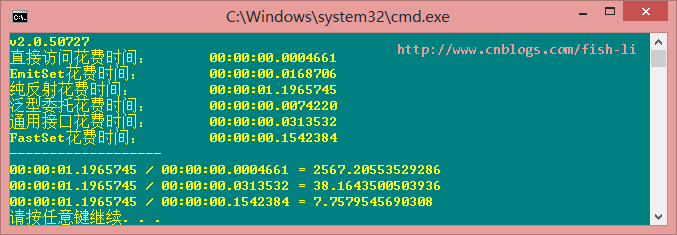反射是一种很重要的技术,然而它与直接调用相比性能要慢很多,因此如何优化反射性能也就成为一个不得不面对的问题。 目前最常见的优化反射性能的方法就是采用委托:用委托的方式调用需要反射调用的方法(或者属性、字段)。
那么如何得到委托呢? 目前最常见也就是二种方法:Emit, ExpressionTree 。其中ExpressionTree可认为是Emit方法的简化版本, 所以Emit是最根本的方法,它采用在运行时动态构造一段IL代码来包装需要反射调用的代码, 这段动态生成的代码满足某个委托的签名,因此最后可以采用委托的方式代替反射调用。
用Emit方法优化反射
如果我们需要设计自己的数据访问层,那么就需要动态创建所有的数据实体对象,尤其是还要为每个数据实体对象的属性赋值, 这里就要涉及用反射的方法对属性执行写操作,为了优化这种反射场景的性能,我们可以用下面的方法来实现:
我用VS2008 (.net 3.5 , CLR 2.0) 测试可以得到以下结果:

从结果可以看出:
1. 反射调用所花时间是直接调用的2629倍,
2. 反射调用所花时间是Emit生成的Set委托代码的82倍,
3. 运行Emit生成的Set委托代码所花时间是直接调用的31倍。
虽然Emit比直接调用还有30倍的差距,但还是比反射调用快80倍左右。
有意思的是,同样的代码,如果用VS2012 ( .net 4.5 , CLR 4.0) 测试可以得到以下结果:

感谢zhangweiwen
在博客中展示了CRL 4.0对反射的性能改进,
在他的博客中还提供了一种采用表达式树的优化版本,以及包含一个泛型的强类型的版本。
Delegate.CreateDelegate也能创建委托
如果我们观察CreatePropertySetter的实现代码,发现这个方法的本质就是创建一个委托:
public static SetValueDelegate CreatePropertySetter(PropertyInfo property) { // ..... 省略前面已贴过的代码 return (SetValueDelegate)dm.CreateDelegate(typeof(SetValueDelegate)); }
看到这里,让我想起Delegate.CreateDelegate方法也能创建一个委托,例如:
OrderInfo testObj = new OrderInfo(); PropertyInfo propInfo = typeof(OrderInfo).GetProperty("OrderID"); Action<OrderInfo, int> setter = (Action<OrderInfo, int>)Delegate.CreateDelegate( typeof(Action<OrderInfo, int>), null, propInfo.GetSetMethod()); setter(testObj, 123);
显然,这是一种很直观的方法,可以得到一个强类型的委托。
然而,这种方法仅限有一种适用场景:明确知道要访问某个类型的某个属性或者方法,因为我们要提供类型参数。 例如:我要写个关键字过滤的HttpMoudle,它需要修改HttpRequest.Form对象的IsReadOnly属性,由于IsReadOnly在NameObjectCollectionBase类型中已申明为protected访问级别, 所以我只能反射操作它了,而且还需要很频繁的设置它。
在绝大部分反射场景中,例如数据访问层中从DataReader或者DataRow加载数据实体,
我们不可能事先知道要加载哪些类型,更不可能知道要加载哪些数据成员,因此就不可能给泛型委托的类型参数赋值,
这个方法看起来也就行不通了。
如果您不信的话,可以看下面修改后的代码:
OrderInfo testObj = new OrderInfo(); PropertyInfo propInfo = typeof(OrderInfo).GetProperty("OrderID"); //Action<OrderInfo, int> setter = (Action<OrderInfo, int>)Delegate.CreateDelegate( // typeof(Action<OrderInfo, int>), null, propInfo.GetSetMethod()); Action<object, object> setter = (Action<object, object>)Delegate.CreateDelegate( typeof(Action<object, object>), null, propInfo.GetSetMethod()); setter(testObj, 123); Console.WriteLine(testObj.OrderID);
虽然能通过编译,但会在运行时报错:

在很多时候,我们只能在运行时得到以Type对象表示的类型,接受object类型才是通用的解决方案。
然而,前面的代码证明了我们不能简单将委托类型从Action<OrderInfo, int>修改为Action<object, object> 。
真的没有办法了吗?
虽然Emit已是很成熟的优化方案,可我还是希望试试 Delegate.CreateDelegate !
用Delegate.CreateDelegate优化反射
当我们用Delegate.CreateDelegate从一个MethodInfo对象创建委托时, 委托的签名必须和MethodInfo表示的方法签名相匹配(有可能不一致), 所以这种方法得到的委托注定是一种强类型的委托。 现在的问题是:我们在运行时构造与指定MethodInfo匹配的委托,如何将Type对象转换成泛型委托的类型参数?
为了解决这个问题,我采用了泛型类来解决泛型委托的类型参数问题:
public class SetterWrapper<TTarget, TValue> { private Action<TTarget, TValue> _setter; public SetterWrapper(PropertyInfo propertyInfo) { if( propertyInfo == null ) throw new ArgumentNullException("propertyInfo"); if( propertyInfo.CanWrite == false ) throw new NotSupportedException("属性不支持写操作。"); MethodInfo m = propertyInfo.GetSetMethod(true); _setter = (Action<TTarget, TValue>)Delegate.CreateDelegate(typeof(Action<TTarget, TValue>), null, m); } public void SetValue(TTarget target, TValue val) { _setter(target, val); }
我用泛型类把Delegate.CreateDelegate的问题解决了,但是如何创建这个类型的实例呢?
可以用Type.MakeGenericType()方法来解决:
public static object CreatePropertySetterWrapper(PropertyInfo propertyInfo) { if( propertyInfo == null ) throw new ArgumentNullException("propertyInfo"); if( propertyInfo.CanWrite == false ) throw new NotSupportedException("属性不支持写操作。"); MethodInfo mi = propertyInfo.GetSetMethod(true); if( mi.GetParameters().Length > 1 ) throw new NotSupportedException("不支持构造索引器属性的委托。"); Type instanceType = typeof(SetterWrapper<,>).MakeGenericType(propertyInfo.DeclaringType, propertyInfo.PropertyType); return Activator.CreateInstance(instanceType, propertyInfo); }
现在问题并没有结束,我又如何调用那些泛型类型实例的委托呢?
这里还有另一个问题要解决:调用方法需要支持object类型(满足通用性)。
我想到了定义一个接口来解决:
public interface ISetValue { void Set(object target, object val); }
然后让SetterWrapper实现ISetValue接口:
public class SetterWrapper<TTarget, TValue> : ISetValue { // ..... 省略前面已贴过的代码 void ISetValue.Set(object target, object val) { _setter((TTarget)target, (TValue)val); } }
还有前面的CreatePropertySetterWrapper方法也需要再次调整返回值类型:
public static ISetValue CreatePropertySetterWrapper(PropertyInfo propertyInfo) { // ..... 省略前面已贴过的代码 return (ISetValue)Activator.CreateInstance(instanceType, propertyInfo); }
考虑到有些特定场景下需要用反射的方式重复操作某一个属性,使用强类型的方法可以避免拆箱装箱,
所以我保留了前面的SetValue方法,让它提供更好的性能,满足一些特定场景的需要。
因此,现在的SetterWrapper类型有二种使用方法,可以提供二种性能不同的实现方法。
现在可以增加二段测试代码来测试它的性能了:
Console.Write("泛型委托花费时间: "); SetterWrapper<OrderInfo, int> setter3 = new SetterWrapper<OrderInfo, int>(propInfo); Stopwatch watch4 = Stopwatch.StartNew(); for( int i = 0; i < count; i++ ) setter3.SetValue(testObj, 123); watch4.Stop(); Console.WriteLine(watch4.Elapsed.ToString()); Console.Write("通用接口花费时间: "); ISetValue setter4 = GetterSetterFactory.CreatePropertySetterWrapper(propInfo); Stopwatch watch5 = Stopwatch.StartNew(); for( int i = 0; i < count; i++ ) setter4.Set(testObj, 123); watch5.Stop(); Console.WriteLine(watch5.Elapsed.ToString());
测试结果如下:

测试结果表明:强类型的泛型委托的速度比Emit生成的Set委托要快,但是基于通用接口的方法调用由于多了一层包装就比Emit方案要略慢一点。
完整的属性优化方案
前面介绍了为属性赋值这类反射案例的优化方案,那么怎么优化读取属性的反射操作呢?
其实思路差不多:
1. 在泛型类中调用Delegate.CreateDelegate,得到一个Func<TTarget, TValue>,
2. 定义一个IGetValue接口,提供一个方法: object Get(object target);
3. 让泛型类实现IGetValue接口
4. 提供一个工厂方法实例化泛型类的实例。
相关代码如下:
public interface IGetValue { object Get(object target); } public static class GetterSetterFactory { public static IGetValue CreatePropertyGetterWrapper(PropertyInfo propertyInfo) { if( propertyInfo == null ) throw new ArgumentNullException("propertyInfo"); if( propertyInfo.CanRead == false ) throw new InvalidOperationException("属性不支持读操作。"); MethodInfo mi = propertyInfo.GetGetMethod(true); if( mi.GetParameters().Length > 0 ) throw new NotSupportedException("不支持构造索引器属性的委托。"); Type instanceType = typeof(GetterWrapper<,>).MakeGenericType(propertyInfo.DeclaringType, propertyInfo.PropertyType); return (IGetValue)Activator.CreateInstance(instanceType, propertyInfo); } } public class GetterWrapper<TTarget, TValue> : IGetValue { private Func<TTarget, TValue> _getter; public GetterWrapper(PropertyInfo propertyInfo) { if( propertyInfo == null ) throw new ArgumentNullException("propertyInfo"); if( propertyInfo.CanRead == false ) throw new InvalidOperationException("属性不支持读操作。"); MethodInfo m = propertyInfo.GetGetMethod(true); _getter = (Func<TTarget, TValue>)Delegate.CreateDelegate(typeof(Func<TTarget, TValue>), null, m); } public TValue GetValue(TTarget target) { return _getter(target); } object IGetValue.Get(object target) { return _getter((TTarget)target); } }
前面的代码优化了实例属性的反射读写性能问题,但是还有极少数时候我们还需要处理静态属性,那么我们还需要再定义二个泛型类来解决:
public class StaticGetterWrapper<TValue> : IGetValue { private Func<TValue> _getter; // ............ } public class StaticSetterWrapper<TValue> : ISetValue { private Action<TValue> _setter; // ............ }
前面看到的工厂方法也要调整,完整代码如下:
public static ISetValue CreatePropertySetterWrapper(PropertyInfo propertyInfo) { if( propertyInfo == null ) throw new ArgumentNullException("propertyInfo"); if( propertyInfo.CanWrite == false ) throw new NotSupportedException("属性不支持写操作。"); MethodInfo mi = propertyInfo.GetSetMethod(true); if( mi.GetParameters().Length > 1 ) throw new NotSupportedException("不支持构造索引器属性的委托。"); if( mi.IsStatic ) { Type instanceType = typeof(StaticSetterWrapper<>).MakeGenericType(propertyInfo.PropertyType); return (ISetValue)Activator.CreateInstance(instanceType, propertyInfo); } else { Type instanceType = typeof(SetterWrapper<,>).MakeGenericType(propertyInfo.DeclaringType, propertyInfo.PropertyType); return (ISetValue)Activator.CreateInstance(instanceType, propertyInfo); } }
委托方案的后续问题
前面的代码解决了属性的读写问题,然而使用它们还很不方便:每次都要创建一个ISetValue接口的实例,再调用它的方法。 其实这也是委托方案共有的问题:我们需要为每个属性的读写操作分别创建不同的委托,而且委托太零散了。
如何将属性与创建好的委托关联起来呢?(创建委托也是需要时间的)
我想所有人都会想到用字典来保存。
是的,好像也只有这一种方法了。
为了提高性能,我改进了工厂类,缓存了包含委托的实例,
为了方便使用前面的方法,我提供了一些扩展方法:
public static class GetterSetterFactory { private static readonly Hashtable s_getterDict = Hashtable.Synchronized(new Hashtable(10240)); private static readonly Hashtable s_setterDict = Hashtable.Synchronized(new Hashtable(10240)); internal static IGetValue GetPropertyGetterWrapper(PropertyInfo propertyInfo) { IGetValue property = (IGetValue)s_getterDict[propertyInfo]; if( property == null ) { property = CreatePropertyGetterWrapper(propertyInfo); s_getterDict[propertyInfo] = property; } return property; } internal static ISetValue GetPropertySetterWrapper(PropertyInfo propertyInfo) { ISetValue property = (ISetValue)s_setterDict[propertyInfo]; if( property == null ) { property = CreatePropertySetterWrapper(propertyInfo); s_setterDict[propertyInfo] = property; } return property; } } public static class PropertyExtensions { public static object FastGetValue(this PropertyInfo propertyInfo, object obj) { if( propertyInfo == null ) throw new ArgumentNullException("propertyInfo"); return GetterSetterFactory.GetPropertyGetterWrapper(propertyInfo).Get(obj); } public static void FastSetValue(this PropertyInfo propertyInfo, object obj, object value) { if( propertyInfo == null ) throw new ArgumentNullException("propertyInfo"); GetterSetterFactory.GetPropertySetterWrapper(propertyInfo).Set(obj, value); } }
说明:我在缓存的设计上并没有使用泛型Dictionary,而是使用了Hashtable。
我承认在简单的单线程测试中,Dictionary要略快于Hashtable 。
再来测试一下FastSetValue的性能吧,毕竟大多数时候我会使用这个扩展方法。
我又在测试代码中增加了一段:
propInfo.FastSetValue(testObj, 123); Console.Write("FastSet花费时间: "); Stopwatch watch6 = Stopwatch.StartNew(); for( int i = 0; i < count; i++ ) propInfo.FastSetValue(testObj, 123); watch6.Stop(); Console.WriteLine(watch6.Elapsed.ToString());
测试结果如下:

测试结果表明:虽然通用接口ISetValue将反射性能优化了37倍,但是最终的FastSetValue将这个数字减少到还不到7倍(在CLR4中还不到5倍)。
看到这个结果您是否也比较郁闷:优化了几十倍的结果,最后却丢了大头,只得到一个零头!
中间那30倍的时间是哪里消耗了?
1. Hashtable的查找时间。
2. 代码的执行路径变长了。
代码的执行路径变长了,我想所有人应该都能接受:为了简化调用并配合缓存一起工作,代码的执行路径确实变长了。
Hashtable的查找时间应该很快吧? 您是不是也这样想呢?
为了看看Hashtable的查找时间,我又加了一点测试代码:
Hashtable table = new Hashtable(); table[propInfo] = new object(); Console.Write("Hashtable花费时间: "); Stopwatch watch7 = Stopwatch.StartNew(); for( int i = 0; i < count; i++ ) { object val = table[propInfo]; } watch7.Stop(); Console.WriteLine(watch7.Elapsed.ToString());
现在运行测试代码的结果如下:

确实,大部分时间消耗在Hashtable的查找上!
缓存的线程并发问题
集合不仅仅只有查找开销,在多线程环境中,我们还要考虑并发性。
看到许多人做性能测试时,总是喜欢写个控制台程序,然后再来个for循环,执行多少万次!
我认为 这样的结果只能反映代码在单线程环境下的性能,在多线程下,结果可能会有较大的差别,
当然了,多线程测试的确很复杂,也很难得到准确的数字。
但是我们的设计不能不考虑多线程下的并发问题。
虽然我也在单线程环境下测试过Dictionary<TKey, TValue>的性能,的确要比Hashtable略好点。
但是MSDN上对Dictionary的线程安全的描述是这样的:
此类型的公共静态(在 Visual Basic 中为 Shared)成员是线程安全的。但不能保证任何实例成员是线程安全的。
只要不修改该集合,Dictionary<(Of <(TKey, TValue>)>) 就可以同时支持多个阅读器。即便如此,从头到尾对一个集合进行枚举本质上并不是一个线程安全的过程。当出现枚举与写访问互相争用这种极少发生的情况时,必须在整个枚举过程中锁定集合。若要允许多个线程访问集合以进行读写操作,则必须实现自己的同步。
而MSDN对Hashtable的线程安全的描述却是:
Hashtable 是线程安全的,可由多个读取器线程和一个写入线程使用。多线程使用时,如果只有一个线程执行写入(更新)操作,则它是线程安全的,从而允许进行无锁定的读取(若编写器序列化为 Hashtable)。若要支持多个编写器,如果没有任何线程在读取 Hashtable 对象,则对 Hashtable 的所有操作都必须通过 Synchronized 方法返回的包装完成。
从头到尾对一个集合进行枚举本质上并不是一个线程安全的过程。即使一个集合已进行同步,其他线程仍可以修改该集合,这将导致枚举数引发异常。若要在枚举过程中保证线程安全,可以在整个枚举过程中锁定集合,或者捕捉由于其他线程进行的更改而引发的异常。
显然,二个集合都不能完全支持多线程的并发读写。
虽然Hashtable提供同步包装的线程安全版本,但是内部还是在使用锁来保证同步的!
没办法,在多线程环境中,任何复杂数据结构都有线程安全问题。
如何保证集合在并发操作中数据的同步呢?
是lock还是ReaderWriterLock?
显然前者的实现较为简单,所以它成了绝大多数人的首选。
在.net4中,ConcurrentDictionary是另一个新的首选方法。
由于Dictionary只支持并发的读操作,所以只要涉及到写操作,它就不安全了,
因此最安全地做法也只好在 读和写 操作上都加lock,否则就不安全了。
而Hashtable则不同,它的内部数据结构支持一个线程写入的同时允许多个线程并发读取,所以只要在写操作上加lock就可以实现线程同步, Hashtable的线程安全版本也就是这样实现的。 这也是我选择Hashtable的原因。
小结
在这篇博客中,我演示了二种不同的反射优化方法:
1. 基于Emit的动态生成符合委托签名的IL代码。
2. 使用Delegate.CreateDelegate直接创建委托。
这是二种截然不同的思路:
1. Emit方法,需要先定义一个委托签名,然后生成符合委托签名的IL代码。
2. CreateDelegate可以直接生成委托,但需要借用泛型类解决委托的类型参数问题,最后为了能通用,需要以接口方式调用强类型委托。
虽然我们可以使用任何一种方法得到委托,但是我们需要操作多少属性呢? 显然这是一个无解的问题,我们只能为每个属性创建不同的委托。所以新的问题也随之产生: 我们如何保存那些委托?如何让它们与属性关联起来? Dictionary或者Hashtable或许是较好的选择(.net 3.5),然而,这些对象内部的数据结构在查找时,并不是零成本, 它们会消耗优化的大部分成果。 另外,在实现缓存委托的问题上,并发问题也是值得我们考虑的,不高效的并发设计还会让优化的成果继续丢失!
所以,我认为优化反射是个复杂问题,至少有3个环节是需要考虑的:
1. 如何得到委托?
2. 如何缓存委托?
3. 如何支持并发?
得到委托是容易的,但它只是一个开始!
博客中所有代码将在后续博客中给出。


 Fish Li (李奇峰)
Fish Li (李奇峰)

 浙公网安备 33010602011771号
浙公网安备 33010602011771号